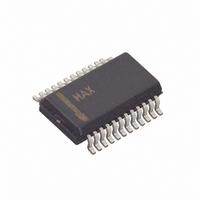MAX9511CEG+ Maxim Integrated Products, MAX9511CEG+ Datasheet - Page 8

MAX9511CEG+
Manufacturer Part Number
MAX9511CEG+
Description
IC INTERFACE VGA 24-QSOP
Manufacturer
Maxim Integrated Products
Type
RGBHV Driverr
Datasheet
1.MAX9511CEGT.pdf
(15 pages)
Specifications of MAX9511CEG+
Applications
Driver
Number Of Circuits
3
Slew Rate
1100 V/µs
Current - Supply
38mA
Current - Output / Channel
40mA
Voltage - Supply, Single/dual (±)
4.5 V ~ 5.5 V
Mounting Type
Surface Mount
Package / Case
24-QSOP
Operating Supply Voltage
4.5 V to 5.5 V
Maximum Operating Temperature
+ 70 C
Maximum Power Dissipation
762 mW
Minimum Operating Temperature
0 C
Mounting Style
SMD/SMT
Lead Free Status / RoHS Status
Lead free / RoHS Compliant
RGBHV Driver with EMI Suppression
8
DDC_DATA_IN
_______________________________________________________________________________________
DDC_CLK_IN
H_SYNC_IN
V_SYNC_IN
GREEN_IN
BLUE_IN
RED_IN
SHDN
V
DD1
-75Ω
-75Ω
-75Ω
R
R
R
SI
SI
R
R
R
PI
AGND
ISENSE
ISENSE
ISENSE
R
PI
V
CC
V
V
V
R
Y
Y
Y
B
DGND
Block Diagram
MAX9511
R
B
R
R
SO
SO
V
V
V
X
X
X
R
PO
R
PO
GREEN_OUT
BLUE_OUT
RX
DDC_DATA_OUT
DDC_CLK_OUT
RED_OUT
V
H_SYNC_OUT
V_SYNC_OUT
DD2
The MAX9511 solves several difficult problems in inter-
facing a video graphics controller to a VGA port and/or
the docking station connector. First, there is a trade-off
between video quality and EMI. The usual method for
reducing EMI is to insert a fixed-frequency LC π-filter
between the video DAC output and the connector. Given
the large component variation of the capacitors and
inductors, the frequency response is sharply reduced to
meet EMI requirements. As a result, video quality suffers
making sharp transitions in the video soft. The MAX9511
video drivers have a variable slew rate, which limits elec-
tromagnetic emissions and can be adjusted by an exter-
nal resistor. As a result, the slew rate of the MAX9511 can
be varied to reduce electromagnetic emissions at a given
resolution, maximizing video quality. Since the slew rate
is variable and set by a resistor instead of fixed by
capacitors and inductors, video performance and elec-
tromagnetic emissions are consistent during production.
The MAX9511 also has horizontal and vertical sync out-
put drivers, bidirectional level translators for DDC sup-
port, and external load-detection circuits that correctly
transfer information about the external load to the video
graphics controller.
Most notebook computers implement a power-saving
load-detection circuit that disables the external monitor
output when no monitor is plugged into the rear panel
VGA connector as shown in Figure 1. Upon startup or on
command, the video controller generates a sequence of
detection pulses out of the current DAC shown, that
results in an output voltage of above 315mV when an
external monitor (R
when disconnected. If the monitor is disconnected at the
time of the pulse, the comparator inside the notebook
trips and disables the video. When the monitor is
plugged in, the resulting pulse will not trip the comparator
and the video is enabled.
If the lowpass filter is simply replaced with an amplifier,
the monitor termination R
controller and the conventional load-detection scheme
does not work.
For this reason, the MAX9511 includes the load-detection
circuit. When R
in) to the output of the MAX9511, the internal load-detec-
tion circuit disconnects the synthesized -75Ω resistor
from the input. The resulting 37.5Ω resistance at the DAC
output indicates to the DAC’s internal load-detection cir-
cuit that the monitor is plugged in. Removing R
connecting the monitor) causes the MAX9511’s
load-detection circuit to connect the synthesized -75Ω
L
is connected (i.e., the monitor is plugged
L
) is connected, and above 630mV
Detailed Description
L
is isolated from the video
Load Detection
L
(i.e., dis-











